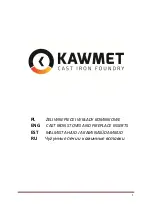
6
CHIMNEY SPECIFICATIONS
If the chimney is ‘cold’, the normal combustion cycle will not work. A cold chimney may be caused by disuse,
being too large, not insulated, being external or not high enough. Exterior chimneys cool rapidly, causing poor
draft and condensation.
CHIMNEY CONNECTOR
The stove should be located as close as possible to the chimney to avoid draft problems. Horizontal flue
connectors restrict the establishment of the required chimney draft and thereby prevent the normal functioning
of the stove. Ensure that the connection is supported and fastened to the stove.
Example:
Wrap plumber’s
strapping around the vertical section of the connector and screw to either edge of the rear heat shield. Ensure
that the strapping is snug fitting (As an alternative support, drill three evenly spaced holes into the connector
and flue collar and attach screws.)
A chimney connector may be used only within the room where the unit is located, between the oil stove and the
chimney but never passing through a combustible ceiling or wall. Minimum connector clearances to combustibles
are to be maintained. If necessary, where local codes allow, a wall thimble may be used.
There are two types of chimney connectors:
THE SINGLE WALL CONNECTOR:
This connector must be 316 grade 26 gauge stainless steel or 1 mm
vitreous enamelled steel and with a 5" (125 mm) diameter. Secure the connector joints with 3 sheet metal
screws. The joints are to be airtight.
All connector sections must be attached to the unit and to each other with the crimped or male end pointing
down towards the oil stove.
CHIMNEY INSTALLATION
An A-Vent chimney, either 4" (100 mm.) or 5" (125 mm.) in diameter may be used. Six inch diameter ‘L’ vent
may be used but only with No. 2 furnace oil. The minimum chimney height is to be 15 feet or 4.6 metres
measured from the appliance flue collar to the top of the chimney but not including any chimney caps. Installa-
tion of all chimney systems is to be in accordance with the chimney manufacturers installation instructions. If
the stove is to be connected to a masonry chimney, a stainless
steel liner is required.
1.
Move the stove into position with the flue centred, mid-
point between two joists to prevent having to cut them. Use a
plumb bob to line up the centre.
2.
Cut and frame an opening in the roof to provide a 2" clear-
ance between the outside of the chimney and any combustible
material. DO NOT FILL THIS SPACE WITH ANY TYPE OF
MATERIAL.
Nail headers between the joist for extra support. Firestop
spacers must be placed on the bottom of each framed opening
in any floor or ceiling that the chimney passes through.
FIGURE
3.
3.
Hold a plumb bob from the underside of the roof to determine where the opening in the roof should be. Cut
and frame the roof opening to maintain proper 2" clearances.
FIGURE 4.
THE TOTAL SMOKE PIPE LENGTH SHOULD NOT EXCEED 40% OF THE CHIMNEY HEIGHT ABOVE
THE STOVE TO A MAXIMUM HORIZONTAL RUN OF 10 FEET.
All smoke pipe must slope upwards at a minimum of 1/4" per foot (6mm/0.3m) and all connections
must be tight and secured by three sheet metal screws equally spaced.
An uninsulated smoke pipe shall not pass through an attic, roof space, closet or similar concealed
space, or through a floor, ceiling, wall or partition, or any combustible construction.
FIGURE 3
FIGURE 4
Содержание Model OS10
Страница 13: ...13 ...
































